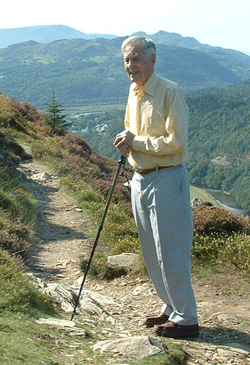Gordon Dowson, luminary of Powder Metallurgy, dies age 99
December 20, 2011
Gordon Dowson was a prominent figure on the European powder metallurgy stage during the 1970’s after he took over the helm of Powder Metallurgy Ltd based in Stratford, in the East End of London, in 1969 at the age of 57.
As Managing Director of one of the then leading copper and copper-based powder manufacturers in Europe he made significant contributions to improving the efficiency of the atomisation plant which had been established by PM pioneer Dr. W.D. Jones on the Stratford site in the mid-1940s.
He also became heavily involved in the development of blending technology to produce large tonnage lots of press-ready bronze premixes for the self-lubricating bearing sector of the PM industry. The advantages to the user of these new premixes were reproducible properties such as dimensional change during sintering of the bearings, compared with in-house mixing of smaller lots at PM plants.
Another of Gordon’s responsibilities was a monthly abstracts journal published by Powder Metallurgy Ltd called Metal Powder Report which was circulated internationally on a subscription basis. The journal had been established by Dr W.D. Jones in 1946 and it was the responsibility of the resident Managing Director of the company to oversee and edit the journal. However, I had been working on the journal since 1967 and Gordon willingly left this task to me. More of my relationship with Gordon later.
His expertise in atomisation technology was again put to good use at PM bearing producer Manganese Bronze Ltd in Ipswich in the early 1980’s, where he acted as a consultant in the design of a water atomisation plant to produce copper-based powders and press-ready bronze premixes. However, Gordon’s connection with powder metallurgy goes back much farther than his time with Powder Metallurgy Ltd and Manganese Bronze Ltd in the 1970’s and 1980’s.
Gordon was born the son of a corn miller in Yorkshire on October 21, 1912 and after attending Batley Grammar School obtained a scholarship for Corpus Christi College, Cambridge University. He graduated in Natural Sciences with Part 2 Chemistry in 1934, and went on to do metallurgical research by delineating a previously unrecognised phase in the CuAl system. He once wrote that, “The research didn’t have any practical use, but it was good training for my PhD”.
In 1937 he joined Baker Platinum to work on precious metal materials, but his career here was interrupted by the Second World War when he moved to ICI in Billingham to do research on materials for the construction of a plant for the separation of isotopes of uranium. This was a critical process in the manufacture of uranium fuel for nuclear power, also for the creation of uranium-based nuclear weapons. For a time Gordon was the world authority on the subject.
It was when he rejoined Baker Platinium, just before the end of the War, that he got his first taste of powder metallurgy. He was involved with the production of thoriated platinum/4% tungsten wire used as an electrode in spark plugs in aircraft engines. The PM process was similar to that used today for producing tungsten lamp filaments, and the new material gave a life three or four times as long as was normal for melted PtW materials. President Roosevelt made public acknowledgement of Gordon’s and the UK’s contribution to this development.
Whilst at Baker Platinum Gordon also invented an atomisation process for producing spherical particles of a ‘special alloy’ used to make fountain pen tips. His prototype used a “pot-bellied corrugated dustbin” as the atomisation chamber in which a steel core rotated at high speed in water. When the molten metal was poured onto the steel core it would split up into droplets which were thrown off into a wall of water. The process was the subject of a successful patent application some three decades later, but the production plant didn’t give anywhere near as good a yield as his ‘prototype dustbin’.
In 1955 Gordon was persuaded to apply for the post of Professor of Chemistry and Metallurgy at the Royal Naval College in Greenwich, a post which carried the rank of Rear-Vice Admiral. He spent fourteen very happy years teaching naval officers at Greenwich College, the great baroque masterpiece of English architecture built by Sir Christopher Wren under Royal Charter in 1694. Unfortunately, his department at the College was merged with the sister Royal Naval College in Dartmouth at which point Gordon left to join Powder Metallurgy Ltd. The Old Royal Naval College is today a museum set in landscaped grounds on the River Thames in the centre of the Maritime Greenwich World Heritage Site.
Since his retirement some 30 years ago, Gordon again became involved with Metal Powder Report which I had in the meantime acquired and relocated to Shrewsbury, Shropshire. Gordon visited Shrewsbury regularly and played an influential role in the development of what became a highly successful journal by either writing reports on visits to PM companies around the world, providing guidance and support to the MPR team both in publishing, and in helping to organise a new series of international PM conferences. This support continued even when the European Powder Metallurgy Association was established in Shrewsbury in 1990 and Metal Powder Report was sold to Elsevier Ltd in Oxford.
For the past 20 years Gordon had been publishing information in MPR on PM patents in North America, Japan and Europe, and many readers found this one of the most important sections of the journal. He paid visits to the British Patent Office in London until he was 95 years of age. He had also published a successful book Powder Metallurgy – the Process and its Products (Adam Hilger, 1990), and his review Introduction to Powder Metallurgy was continually updated for numerous editions of the International Powder Metallurgy Directory (IPMD). This review was to become the basis for a booklet that was circulated to thousands of students and engineers by the European Powder Metallurgy Association (EPMA) during the 1990’s and beyond.
Gordon was also for many years Chairman of the ISO TC 119 Standards Sub-Committee on ‘Powder Metallurgy Terminology’.
My relationship with Gordon, which started at Powder Metallurgy Ltd in London in the late 1960’s, extended for over 40 years. In that time we shared not only professional experiences but also cemented our friendship by climbing Alpine peaks and ski mountaineering in Austria and Switzerland. There were also regular treks into the mountains of Wales until Gordon’s mid 90’s.
Our most treasured experiences were always during the 4-yearly Plansee PM Seminars in Reutte, Austria, when ascents were made of the local peaks. Particularly satisfying was the ascent at the third attempt of the Matterhorn-like ‘Sonnenspitze’ when Gordon was a mere 80 years old. Sport has played an important part in Gordon’s life and in addition to walking and mountaineering he played hockey and tennis. He also enjoyed gardening, beekeeping and playing bridge. His wife Joyce died in 2004 and he is survived by his son Robin.
Gordon Dowson died at the Eversleigh Nursing Home, Bromley, Kent on December 18, 2011.
Author: Bernard Williams, Shrewsbury, UK, email: [email protected]
















